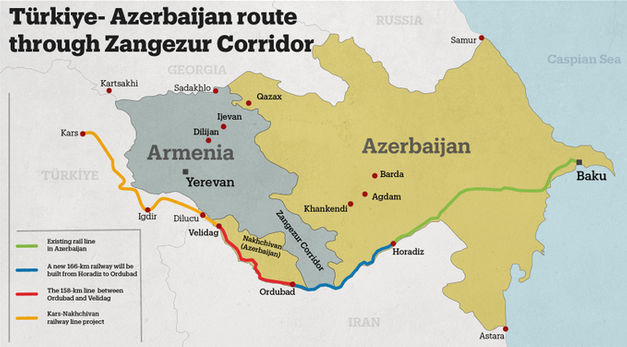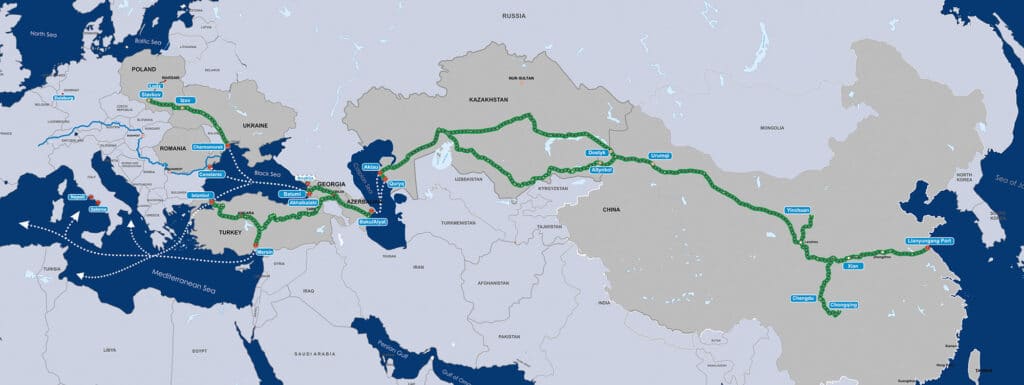The New Developing Eurasian Transit Corridors: The Zangezur and Trans-Caspian Prospects
Comparing the two main East-West Rail Transportation Arteries
In the context of sanctions pressures and the minimisation of contacts with Europe, the eastern focus of Russian transportation and logistics policy is becoming increasingly more significant across the Eurasian continent. The development of the economic and transport interconnectivity of Eurasia is one of the important tasks reflected in the new Russian Foreign Policy Concept. In this article we look at these corridors and assess their eastbound potential.
Against the backdrop of the increased desire of the West to isolate Russia, Moscow began to realise the need for the speedy construction of a new transport and logistics infrastructure to the east and finishing with access to China. A special role within this is assigned to the International North-South Transportation Corridor (INSTC), which, with the shifting centres of Eurasian economic activity, can compete with the largest logistics corridors.
The INSTC is becoming one of the most important for Russia both in terms of overcoming international isolation and in terms of organising import-export operations that make it possible to circumvent Western sanctions. Moscow is interested in constructive interaction with Azerbaijan and Iran as the states on which the implementation of one of the important logistical directions of the North-South corridor largely depends.
The political crisis that overshadowed Iranian-Azerbaijani relations in January 2023 does not meet the interests of Russia, like any other manifestations of destabilisation in the Caspian region. It can interfere with the joint work of states in the development and development of this important transport route. In such a tense geopolitical environment, the issues of modifying old routes are attracting more and more attention. Such is the project of the Zangezur corridor.
The Zangezur Corridor

This controversial route is planned to connect Azerbaijan with the Nakhichevan Autonomous Republic (NAR). The NAT is geographically separated from Azerbaijan by Armenia, with the two sides fighting over the region. A tense peace is now maintained, although the NAR is now to be connected under Armenian agreement and Russian monitoring by a railway passing through the Zangezur region of Armenia.
Baku continues to build railways in areas under its control, while Yerevan sees a threat to its security in the project lobbied by the Azerbaijani side. Armenia’s consent to the laying of a new transport corridor through its territory depends on the results of negotiations with Azerbaijan on the delimitation and demarcation of the border. These have proven problematic, even though the concept could assist land-locked Armenian products access the INSTC.
Russia’s position regarding the Zangezur corridor is influenced by Moscow’s desire to maintain friendly relations with all the states involved in this project Azerbaijan, Armenia, Iran and Turkiye. In addition, Azerbaijan and Iran are of interest to Russia not only as trade and economic partners, but also as key participants in the INSTC.
However, the Zangezur Corridor appears more likely at present to be implemented as a local logistics project, as the development of the route is hampered by competing interests and regional politics. That said, Azerbaijan has completed about 45% of the railway connectivity on its side.
The Trans-Caspian, Middle East-West Corridor

Equally ambiguous are the possibilities for the functioning of another project, the renewed Trans-Caspian, which is aimed at bypassing the territory of Russia. The Trans-Caspian Initiative, Middle East-West Corridor was conceived for the transportation of goods from China to Europe through Russia and Kazakhstan. Since 2014, there have been attempts to change the geography of the route. The search for alternatives is carried out within the framework of the Trans-Caspian International Transport Route (TITR), where the leading positions are occupied by Azerbaijan, Georgia, Kazakhstan and Turkiye.
The TITR and other alternative transport projects to Russia are of interest to the West in order to limit the contacts of the countries of Central Asia with Russia and to realise their own plans.
Kazakhstan and Azerbaijan have come forward as the main lobbyists for the TITR, behind which Turkiye is present, along with Western (mainly British) companies that control the oil and gas sector of these two former Soviet republics and are interested in laying alternative routes for the supply of energy resources to the EU markets.
But this project also has significant shortcomings. The countries through which they are trying to build alternative trade and transport routes to Russia do not have infrastructure with adequate capacity.
This means that the transit of goods along the TITR route is complicated by difficult geography, forcing carriers to first reload goods delivered from China and other countries by rail or road to ships crossing the Caspian and Black Seas, and subsequently repeating the same procedure on the way back. But this cargo delivery option is much more expensive, and it takes much longer than the flow of goods through Russia territory.
As a result, the volume of traffic from China, for example, using the infrastructure of the Trans-Siberian and Trans-Mongolian Russian Railways, turns out to be higher than the volume of TITR services. Even if the participants of the TITR manage to take on the delivery of some part of the cargo, this corridor, due to its limited capacity, will not become a full-fledged replacement for transport routes through the territory of Russia.
If the Zangezur corridor has future prospects due to its economic feasibility, then the TITR initiative, which is being heavily adjusted to the interests of the West and Turkiye, remains mainly on the political agenda of the countries concerned.
Source: AsiaIs
Related Reading
 RUSSIA’S PIVOT TO ASIA
RUSSIA’S PIVOT TO ASIA




